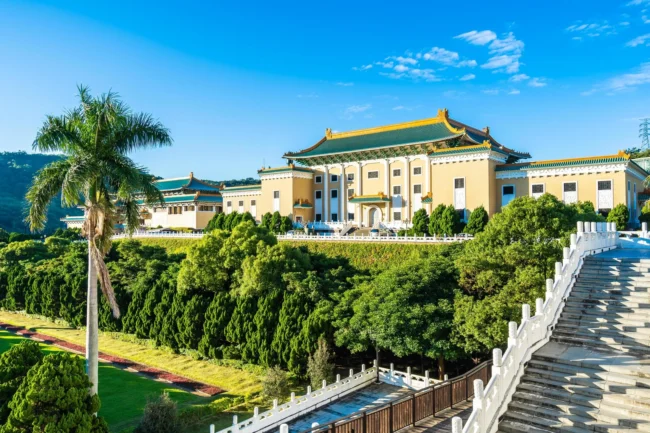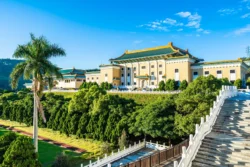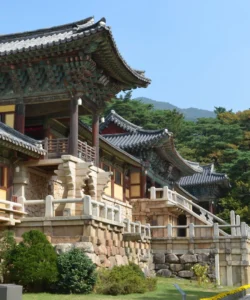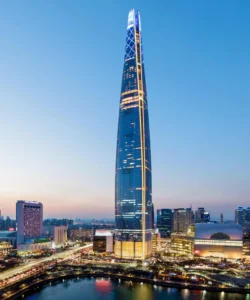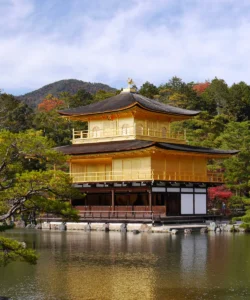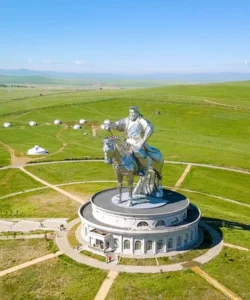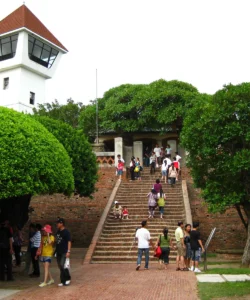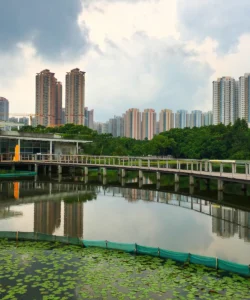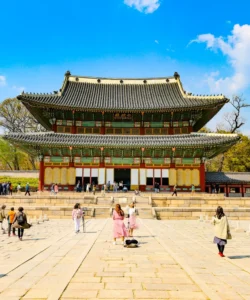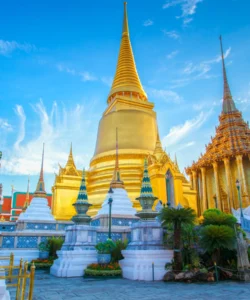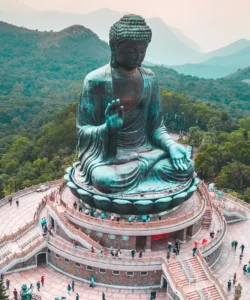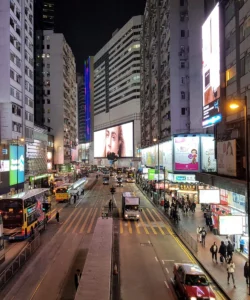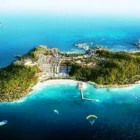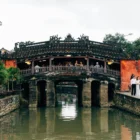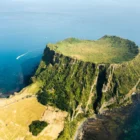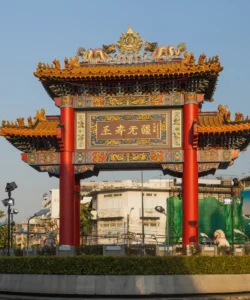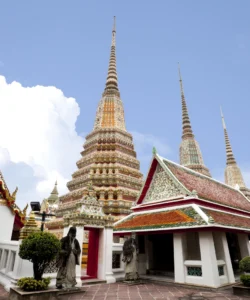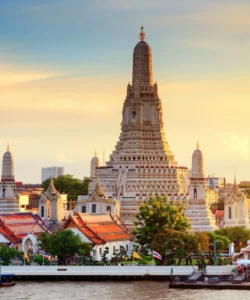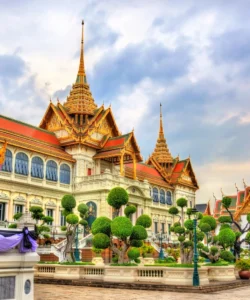The National Palace Museum (NPM) in Taipei, Taiwan, is one of the world’s largest and most impressive museums of Chinese art and artifacts. Housing a permanent collection of nearly 700,000 pieces, primarily comprising priceless items relocated from Beijing’s Forbidden City during the Chinese Civil War, it spans over 8,000 years of Chinese history from the Neolithic age to the modern era. The museum is a living testament to the grandeur and continuity of Chinese civilization, revered globally for the sheer quality and breadth of its imperial collection.
Name: National Palace Museum (國立故宮博物院, Guólì Gùgōng Bówùyuàn)
Address: No. 221, Section 2, Zhishan Road, Shilin District, Taipei City, Taiwan 111. It’s located in the northern suburbs of Taipei.
How to get there:
The National Palace Museum is well-connected by Taipei’s public transport system:
- By MRT (Taipei Metro) and Bus:
- Take the Tamsui-Xinyi Line (Red Line) to Shilin Station (R16). From Exit 1, walk 1-2 minutes to the bus stops on Zhongzheng Road. Take bus R30 (Red 30) directly to the B1 entrance of the museum’s Main Building. Other buses (e.g., 815, 304, 300, 255, S19, S18, M1) also go to the museum, but the R30 is often recommended as it stops closest.
- Alternatively, take the Wenhu Line (Brown Line) to Jiannan Road Station (BR15, Exit 1) or Dazhi Station (BR14, Exit 3). From Jiannan Road, take bus BR20 (Brown 20) to the museum’s front entrance. From Dazhi, take bus BR13 (Brown 13).
- By Taxi/Ride-Sharing Services: Taxis are readily available throughout Taipei and offer a direct way to reach the museum.
- By Car: Parking is available at the museum, though it can be limited during peak hours.
Landscape and Architecture:
The National Palace Museum’s main building is an imposing and elegant structure, designed in the style of a traditional Chinese palace, set amidst lush green mountains:
- Main Building (Chinese Palace Style): The primary museum building, opened in 1965, is a grand edifice with a distinctive green tile roof and yellow walls, evoking the majestic appearance of traditional Northern Chinese imperial palaces. It features traditional elements like upturned eaves, intricate carvings, and a harmonious balance of forms. The design blends traditional aesthetics with functional museum requirements.
- Zhishan Garden (至善園): Located within the museum compound, this classical Chinese Song and Ming style garden is a meticulously designed space. It incorporates principles of feng shui, traditional architecture, water management, and Chinese folklore. It features numerous ponds, waterworks, pavilions, and carefully placed rocks and plants, offering a tranquil retreat and insights into traditional Chinese garden design.
- Zhi Shan Yuan (至善園): This is a newer, larger Chinese-style garden that also blends traditional elements with modern landscape design.
- Mountainous Backdrop: The museum is nestled against a backdrop of verdant mountains in the Shilin district, which adds to its serene and traditional aesthetic, making it feel somewhat removed from the urban bustle despite being well within city limits.
- Modern Amenities: While classical in appearance, the museum features state-of-the-art climate control, security, and exhibition technologies to preserve its priceless collection.
What makes it famous:
The National Palace Museum is famous for:
- World-Class Collection of Chinese Imperial Artifacts: It holds one of the most comprehensive and highest-quality collections of Chinese imperial artifacts and artworks in the world. Its nearly 700,000 pieces span over 8,000 years of Chinese history, from the Neolithic period to the Qing Dynasty. This collection largely comprises items relocated from the Palace Museum in Beijing (Forbidden City) by the Kuomintang government during the Chinese Civil War.
- Iconic Masterpieces: It is home to several globally renowned “treasures” that draw massive crowds:
- Jadeite Cabbage (翠玉白菜): An exquisitely carved piece of jadeite resembling a cabbage head with a large and small grasshopper camouflaged in the leaves, famous for its natural color variations and intricate detail.
- Meat-shaped Stone (肉形石): A piece of jasper cleverly carved and colored to resemble a piece of braised pork belly, strikingly lifelike.
- Mao Gong Ding (毛公鼎): A bronze cauldron from the Western Zhou Dynasty with the longest Chinese bronze inscription (497 characters) discovered so far.
- Carved Olive Pit Boat (雕橄欖核舟): A tiny boat carved from an olive pit, containing eight figures and an inscription of over 300 characters, showcasing incredible miniature craftsmanship.
- Historical Significance: The museum’s very existence is a result of a pivotal moment in 20th-century Chinese history, reflecting the complex political relationship between Taiwan and mainland China.
- Rotating Exhibitions: Due to the sheer size of its collection, only a small fraction (around 3,000-5,000 pieces) can be displayed at any given time. The museum frequently rotates its exhibitions, ensuring there’s always something new to see, even for repeat visitors.
- Educational and Cultural Hub: It serves as a vital institution for the study and appreciation of Chinese art, culture, and history, attracting millions of visitors annually.
Differences from some other wonders:
The National Palace Museum in Taipei is unique among major museums and other wonders in several ways, particularly when compared to its “sibling” institution, the Palace Museum in Beijing:
- Custody of Imperial Collection: Its defining characteristic is that it holds the choicest and most portable portion of China’s imperial art collection, removed from the Forbidden City in Beijing during the Chinese Civil War. This makes it, arguably, the most comprehensive single repository of Chinese imperial movable treasures, whereas the Palace Museum in Beijing primarily houses the imperial palace itself and the unmovable artifacts within.
- Purpose-Built Museum vs. Palace-Turned-Museum: Unlike the Palace Museum in Beijing, which is the actual imperial palace (the Forbidden City) repurposed as a museum, the National Palace Museum in Taipei is a modern, purpose-built museum (completed in 1965), albeit designed in a traditional palace style. This means its infrastructure is specifically optimized for display, preservation, and visitor flow, contrasting with the challenges of converting ancient palace structures for museum purposes.
- Focus on Artifacts vs. Architecture: While the Beijing Palace Museum emphasizes the grandeur of the imperial palace architecture itself, the Taipei NPM places a strong emphasis on the artifacts and artworks within its collection. For art historians and enthusiasts, Taipei is often considered superior for the quality and depth of its movable pieces.
- Symbol of ROC/Taiwanese Identity: The museum subtly (and sometimes overtly) acts as a symbol of the Republic of China’s (Taiwan’s) claim to be the legitimate inheritor of traditional Chinese culture, distinct from the Chinese Communist Party’s narrative. This political and cultural legitimacy aspect is a unique layer to its identity.
- Frequent Rotation of Exhibits: The museum’s rigorous schedule of rotating vast portions of its collection means that no single visit can encompass all its treasures, encouraging repeat visits and offering fresh experiences, which is a different model from museums with more static permanent displays.
In essence, the National Palace Museum, Taipei, is not just a museum; it is a repository of a civilization’s artistic soul, a witness to tumultuous history, and a grand display of human creativity and ingenuity, all housed in a setting that bridges traditional aesthetics with modern museology.\
